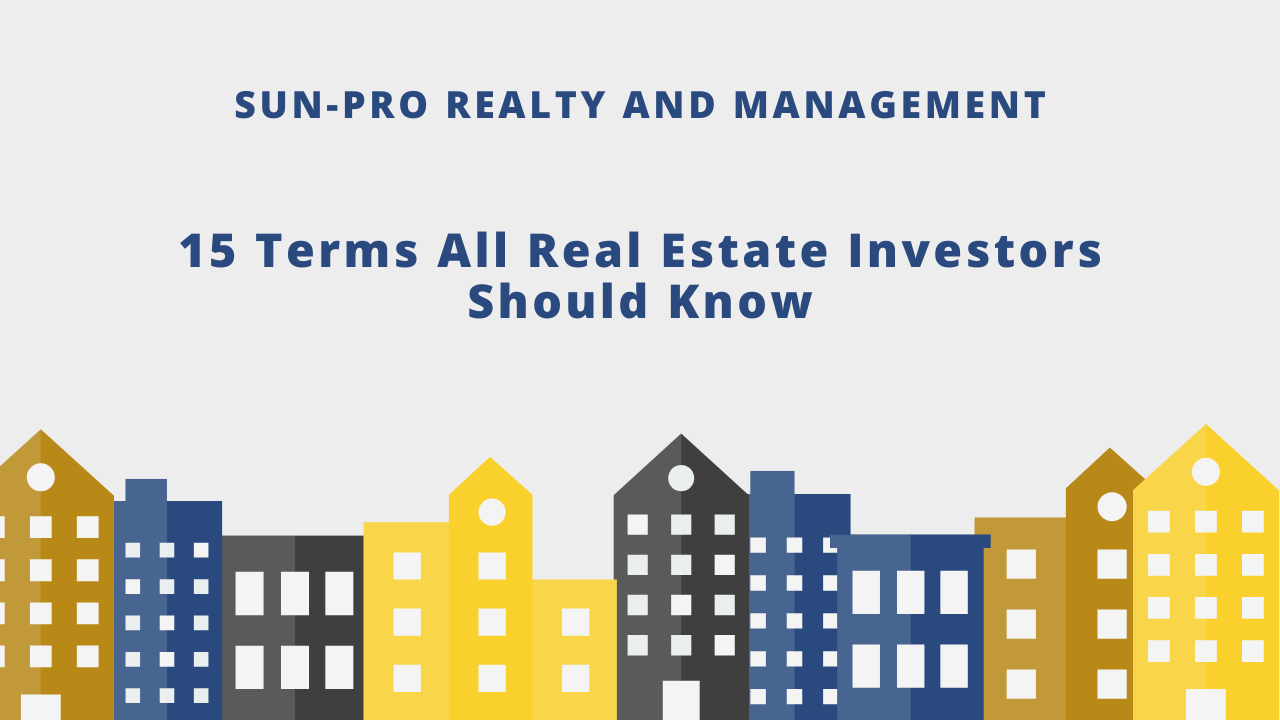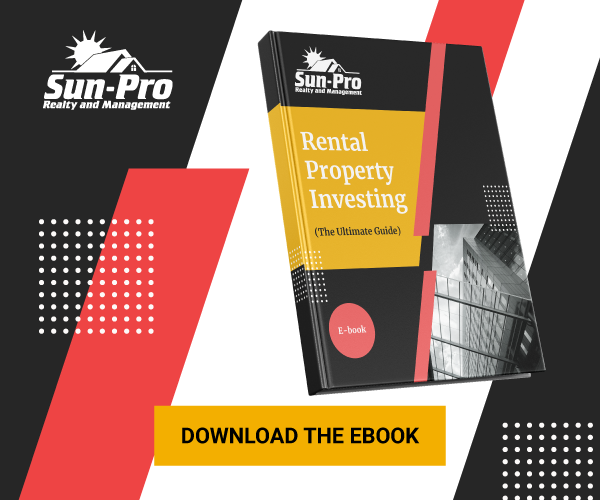
Key Takeaways
- Know the Terms: Understanding key real estate terms helps landlords make smarter, more profitable decisions.
- Watch the Numbers: Metrics like cash flow, NOI, and vacancy rate directly impact your bottom line.
- Get Expert Help: Sun-Pro Realty and Management turns knowledge into action with professional, results-driven support.
Are you confident in your understanding of the language used in property transactions, financing, and management?
Successful real estate investing requires understanding key industry terms that impact your profits, responsibilities, and risk. Without a working knowledge of common real estate terms, landlords can miss important details in contracts, or overpay for services in their property management strategies.
To help landlords operate more efficiently and profitably, Sun-Pro Realty and Management put together this practical guide that outlines the essential terms every real estate investor should know.
Essential Terms Every Landlord Should Know
Cash Flow
Cash flow refers to the money left over after all operating expenses are deducted from rental income. This includes mortgage payments, taxes, insurance, repairs, and management fees. Positive cash flow means your investment is earning money.
Negative cash flow means your rental property is costing more to operate than it earns in income each month. Understanding your property’s cash flow helps you make decisions on whether to hold, sell, or improve the property.
Net Operating Income (NOI)
NOI is the total income from a property after operating expenses are deducted, but before taxes and financing costs. It is a key measure used to evaluate a property's ability to generate profit.
For example, if a property generates $50,000 in rental income and has $20,000 in expenses, the NOI is $30,000. Lenders and investors often use NOI to evaluate property performance.
.jpg)
Cap Rate (Capitalization Rate)
The capitalization rate, or cap rate, is a real estate metric that helps estimate the potential return on an investment property. It is determined by dividing the NOI by the property's purchase price or current market value.
For example, if a property has a $40,000 NOI and is valued at $800,000, the cap rate would be 5%. Cap rates vary by location and property type, and they help investors compare different opportunities.
Equity
Equity represents the amount of ownership you have in a property. It is the difference between the property’s market value and any outstanding mortgage balance.
As you pay down the mortgage or as property values increase, your equity grows. Equity can be used to secure additional loans or as profit if you decide to sell.
Appreciation
Appreciation is the rise in a property's value over time, often due to market trends, improvements, or neighborhood development.
While not guaranteed, appreciation is a major benefit of long-term property ownership. Landlords should track local trends to understand their property’s potential for appreciation.
Depreciation
Depreciation is a tax deduction that allows investors to recover the cost of an income-generating property over time, typically 27.5 years for residential real estate.
This non-cash deduction can reduce taxable income and improve your investment’s financial performance. However, depreciation may be subject to recapture when you sell the property.
Gross Rent Multiplier (GRM)
The GRM is a simple calculation used to evaluate a property’s value compared to its rental income. It is calculated by dividing the purchase price by the annual gross rent.

A lower GRM may indicate a better investment opportunity, but it should not be used alone. GRM does not consider expenses or vacancies, so it’s best used as a quick screening tool.
Operating Expenses
These are the costs associated with running a rental property. They include utilities (if paid by the landlord), repairs, maintenance, insurance, property management, property taxes, and advertising.
Knowing your operating expenses helps you evaluate the property’s profitability and make informed budgeting decisions.
Vacancy Rate
This term refers to the percentage of time a rental property is not occupied. A high vacancy rate can significantly impact income.
For example, if your unit is empty for 2 months out of 12, the vacancy rate is about 16.7 percent. Landlords should aim to keep vacancy rates low through competitive pricing, proper maintenance, and good tenant communication.
Leverage
Leverage refers to using borrowed money to purchase or improve a property. Most investors use a mortgage to finance their investments.
Leverage can amplify returns but also increases risk. If property values drop or rents fall, highly leveraged properties can become a liability. Managing leverage carefully is crucial to long-term success.
Tenant Screening
Tenant screening involves evaluating potential renters based on their credit, income, rental history, and background.
A thorough screening process reduces the risk of late payments, damage, and eviction. Landlords should have a consistent process in place to ensure they select reliable tenants.
Lease Agreement
The lease agreement is a legally binding document outlining the terms and conditions under which a tenant rents the property.
.jpg)
It should clearly include rent amount, payment due dates, maintenance responsibilities, rules for occupancy, and the process for renewing or terminating the lease. Having a solid lease protects both the landlord and tenant.
Eviction Process
Eviction is the legal procedure to remove a tenant from the property due to non-payment or lease violations that varies by state.
Landlords must follow these carefully to avoid legal issues. Being familiar with the eviction process helps landlords respond properly to tenant problems.
Turnover Costs
These are the expenses related to preparing a unit for a new tenant. They can include cleaning, repairs, painting, and advertising. High turnover increases costs and reduces income. Keeping good tenants longer helps minimize turnover costs and maintains steady cash flow.
1031 Exchange
A 1031 exchange allows investors to defer capital gains taxes by reinvesting the proceeds from a property sale into a similar property.
This tool is useful for growing a real estate portfolio without immediate tax consequences. However, it has strict timelines and requirements that must be followed.
Bottom Line
Understanding these essential real estate terms helps landlords make informed financial and operational decisions.
From evaluating property performance to managing day-to-day operations, having a solid grasp of these definitions can directly impact profitability and reduce costly mistakes.
Whether you’re buying, leasing, managing, or selling property, these terms form the foundation of smart real estate investing.
Sun-Pro Realty and Management helps landlords put this knowledge into practice. From accurate financial reporting to strategic property management, our team ensures that your investments operate smoothly and efficiently. Contact Sun-Pro Realty and Management today!
